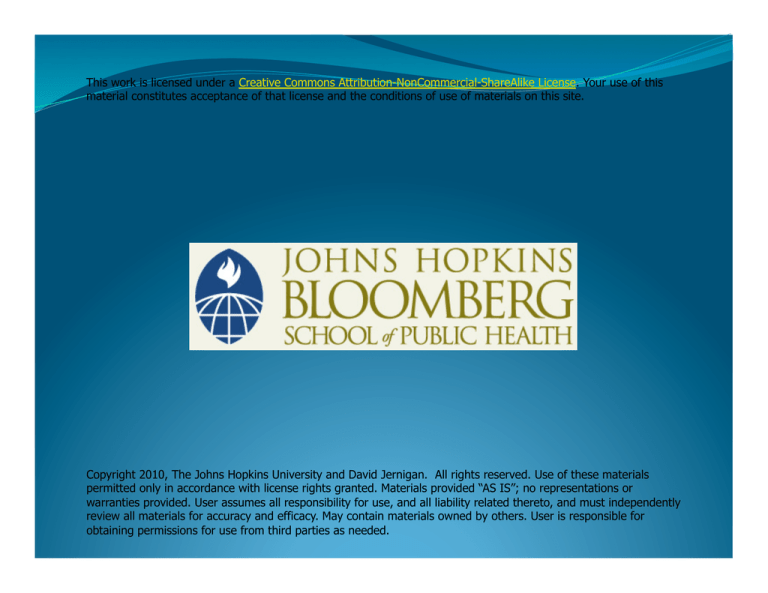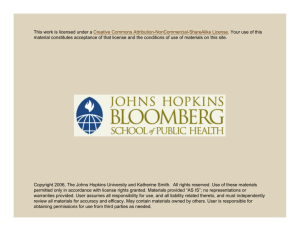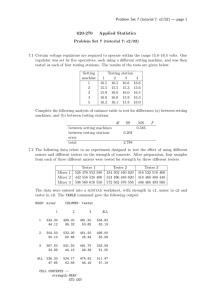
This work is licensed under a Creative Commons Attribution-NonCommercial-ShareAlike License. Your use of this
material constitutes acceptance of that license and the conditions of use of materials on this site.
Copyright 2010, The Johns Hopkins University and David Jernigan. All rights reserved. Use of these materials
permitted only in accordance with license rights granted. Materials provided “AS IS”; no representations or
warranties provided. User assumes all responsibility for use, and all liability related thereto, and must independently
review all materials for accuracy and efficacy. May contain materials owned by others. User is responsible for
obtaining permissions for use from third parties as needed.
Class Objec+ves Differentiate between sex and gender Consider the importance of sex and gender as health determinants Discuss various pathways through which gender and sex differences impact health outcomes Elucidate research agenda on sex, gender and health Sex and Gender
Sex and Gender are not interchangeable terms Sex is defined biologically & physiologically Even these terms are socially fluid Gender roles are socially constructed and usually framed as an extension of biologically determined social functions Sex difference is used to refer to primarily biological variables and the term gender difference is used to refer to psychosocial and cultural variables “Male” and “female” are often sex categories, while “masculine” and “feminine” are clearly gender categories.
Sex and Health There are biological differences between men and women that lead to differential health outcomes Differences in perinatal mortality – female infants have a lower mortality rate than male infants The effect of sex differences is fairly stable across societies What can social science research/study of organization of society tell us about differential relationships to and processing of risk behavior? What is Gender?
A socially constructed term referring to roles,
behaviors, activities, and attributes that a given
society considers appropriate for men and women.
Encompasses physiology
Culturally bound but historically persistent
Gender Inequality and Health Two conceptually distinct dimensions 1. Biologically specific health needs that are not equally accommodated 2. Inequalities in health status and health care arising from the nature of larger societal gender relations Gender and Income Leading Cause of Death by Gender, U.S., 2005 Life expectancy (2005): Male 75.2 years, female 80.4 years
Sources: CDC WISQARS, NCHS (life expectancies).
Women’s Health Women live longer than men, an average of five years longer -­‐ but they tend to be ‘sicker’ than men (male-­‐female health-­‐survival paradox) (Apfel, 1982; Waldron, 1994; Oksuzyan et al. 2008) Longer life expectancy holds across ethnic groups and nations but the gap is decreasing (Verbrugge, 1985; Walsh, et al., 1995) When social discrimination decreases, women’s life expectancy increases (Waldron, 1983) Men’s Health
Compared to women:
Men have higher rates of fatal illnesses
Men have more toxic occupational exposure
Men have higher rates of injuries (both
intentional and non-intentional)
Source: Verbrugge, 1985; Walsh, et al., 1995
Full-­‐page ad in the New York Times, 1991 “Women don’t get AIDS, they just die from it.” Women and Public Health Women’s issues ignored In HIV research and prevention In clinical trials Including differences from men in prognosis, diagnosis, and progression of disease In research on women-­‐specific health issues Women’s issues assumed to be limited to maternal and child health One result is women under-­‐diagnosed in realms like alcohol and other drug use What Accounts for the Gender
Gap in Health?
Women are often the health care gatekeeper for
the family
Women seek healthcare more often for their
children AND themselves
Women may experience more symptoms and
more pain
Biological differences?
Manifestations of culture
Gender Roles -­‐ Protec+ve or Damaging to Health? In the U.S. (and most other countries), women earn significantly less money than men for similar work -­‐ However In Viet Nam, many more men than women smoke, as female smoking has not traditionally been considered appropriate In Saudi Arabia, men are allowed to drive cars while women are not, which in turn has been argued to protect women Source: WHO, http://www.who.int/gender/whatisgender/en/index.html
Social Science Studies of Gender Gap in Health Important topic because of magnitude of differences Research is provocative and sometimes surprising Clear that social factors are playing substantial role but often difficult to understand or predict why and how Compe+ng or Complementary Explanatory Models Differential Exposure
Women report higher levels of health problems because of reduced access to material and social conditions that foster health and greater stress associated with gender and marital roles Differential Vulnerability
Women report higher levels of health problems because they react differently than men to the material, behavioral and psychosocial conditions that foster health Canadian Na+onal Popula+on Health Survey Both hypotheses receive support Canadian women report lower levels of self-­‐rated health and functional health, higher levels of stress, and more chronic health problems Structural determinants of health (socio-­‐economic, age, social support, family arrangement) explain largest portion of variance in self-­‐rated, functional and chronic health Pyschosocial determinants (critical life events,stress, psychological resources) are strongest predictors of distress Source: Denton et al. 2004
Canadian Na+onal Popula+on Health Survey Factors affecting health in both genders: age, family structure, main activity, education, income, occupation and social support Factors affecting men’s health Smoking, alcohol use, physical activity Factors affecting women’s health Body weight, impact of childhood/life events, chronic stressors, psychological resources Source: Denton et al. 2004
Case example – Gender and Mental Health (overall) No real differences between sexes in overall prevalence of mental and behavioral disorders Childhood: boys have higher antisocial & conduct disorders Adolescence: Girls have higher depression, eating disorders and suicidal ideation Adult: women have higher depression, men higher substance abuse Older age: Alzheimer’s disease incidence similar, but higher #s in women b/c they live longer Source: WHO (2002) Gender and Mental Health
http://www.who.int/gender/other_health/en/genderMH.pdf
Gender ra+o of psychotropic drug use by country Source: WHO (2002) Gender and Mental Health
http://www.who.int/gender/other_health/en/genderMH.pdf
Case example – Gender and Mental Health (Sex differences) Mood swings as part of menstrual cycle contribute to some depressive and anxiety disorders Infertility and hysterectomy may increase women’s risk of affective/neurotic syndromes Bladder control problems are more common in older women, and are associated with depression and emotional distress Relationship between men’s reproductive and mental health is under-­‐explored. Source: WHO (2002) Gender and Mental Health
http://www.who.int/gender/other_health/en/genderMH.pdf
Case example – Gender and Mental Health (Gender differences) Depression is established to be associated with feeling out of control and having low autonomy. Socially defined gender roles place women in such positions at higher rates than men. Socialization of men not to express emotion may lead to heightened distress at times of loss/grief Gender differences in perceptions of distress and patterns of care seeking – women seek help earlier Help may also be given to women earlier than to men Source: WHO (2002) Gender and Mental Health
http://www.who.int/gender/other_health/en/genderMH.pdf
Case example: marriage Numerous studies have shown marriage to be related to positive health outcomes. Men benefit from marriage more than women¹ What mechanisms may be driving this effect and the differences? (Direct effects, positive selection and adverse selection all possible) Marriage and health -­‐ pathways Protection from risk behaviors Emotional support of spouse is beneficial Stimulates healthier lifestyle decisions within family Improved financial stability Single older men more likely to live alone – miss out on social integration Case example: gender and HIV, 1990-­‐2007 Source: http://data.unaids.org/pub/EPISlides/2007/2007_epiupdate_en.pdf
The Different “Lenses” Used to Examine Gender and Health 1.
Biomedical (genetic, hormone, anatomic) 2.
Psychosocial (personality, coping, self efficacy, 3.
Epidemiological (risk factors – behavioral and etc.) environmental) 4. Socio-­‐structural (large scale structured power differentials) Source: Kawachi et al 1999 Individual-­‐level explana+ons Framework Key questions Biomedical How do humans, as biological organisms, become ill? Behavioral/lifestyle How do individual behavioral and cultural factors affect health and disease? Psychological What motivates individuals to change behaviors that increase risk of disease? Source: Zierler and Krieger 1997
Structural-­‐level explana+ons Framework
Key questions
Feminist
How do gender inequalities
affect health of women (as
well as men and children)?
Social production of disease;
political economy of health
How do economic and social
relations forged by society’s
economic, social and political
structures, affect health?
Ecosocial
How do developmental and
evolutionary biology interact
with social, economic and
political conditions to explain
population patterns of health,
disease and well-being?
Human rights
How do violations of human
rights drive population patterns
of disease?
Structural-­‐level explana+ons (1) Structural-­‐level explana+ons (2) Human Rights: Effects of Status of Women on Health Women’s status in each of 50 states, measured by: Political participation
Women elected to office, women registered to vote and who voted, institutional resources for women (e.g. Commissions on Status of Women) Employment and earnings
Median annual full-­‐time earnings, M/F earnings ratio, percent of women in labor force, percent of women in managerial or professional occupations Economic autonomy
Percent women with four or more years of college Percent women without health insurance Percent women in poverty Percent of businesses owned by women Reproductive rights
Eight measures of legislative and political indicators of reproductive health and autonomy Source: Kawachi et al. 1999
Human Rights: Effects of Status of Women on Health Effects on health: Political participation
Higher the score, lower women’s mortality rates Also associated with lower male mortality rates (even stronger) For women, especially mortality from ischaemic heart disease, cervical cancer Employment and earnings
Associated with male mortality rates but not female Associated with female death rates from cerebrovascular disease, ischaemic heart disease (marginal) Economic autonomy
Strongly associated with male and female mortality rates – stronger for males than females Related to female death rates from cerebrovascular disease, cervical cancer, homicide and to infant mortality. Reproductive rights
Not associated with female mortality – only association was with infant mortality Source: Kawachi et al. 1999
Women’s health and social change Takeda et al. 2006: effects of changes in gender roles in Japan on health 3011 females, 2682 males Examining proliferation of multiple roles within each gender:
Marital Employment Parenting Caregiver (e.g. of elderly parent) Studied nine possible combinations of these roles Women’s health and social change Takeda et al. 2006: effects of changes in gender roles in Japan on health Youngers (20-­‐39) Smoking and drinking risk rises for men with multiple roles Drinking risk rises for women with multiple roles Olders (40-­‐59) Risk of smoking falls for women with multiple roles, but also less likely to exercise regularly or go for check-­‐ups, more likely to report more health problems Middle-­‐aged men – more the roles, lower the odds of reporting health problems Women’s health and social change Sexualization of society Changes in girls’ drinking patterns “Sex and the City” Proliferation of alcohol advertising on television (especially distilled spirits) Introduction of new female-­‐oriented products Change in beverage preference of binge-­‐drinking female high school seniors Relationships largely unstudied In Sum … We know that biologically, one’s sex influences health outcomes IN ADDITION: Social structures mean that one’s gender also has important health implications in terms of: Life position and power Access to resources and services Engagement in risk behaviors Environmental exposures Gender and Health – Policy Issues
Different needs of developing and industrialized
nations
Status improvement and empowerment will improve
women’s health
Decreases in public expenditure hit women harder
Focus on risk/dangerous behavior necessary (for
both men & women) to reduce the gender gap in
mortality
Ques+ons for a gender crusade Is improving the well-­‐being of women an end in itself or a means to an end? Do human rights issues trump all else? What is the line between legitimate intervention and cultural imperialism? Who speaks for women? What about the men and the boys? Does making girls winners make boys losers, e.g. by ignoring disparities in intentional and unintentional injuries? Source: Levine R. Reflections on NYT Magazine Special Issue on Gender: Three Questions to Guide the New Crusade, available at
http://blogs.cgdev.org/globalhealth/2009/08/reflections-on-nyt-magazine-special-issue-on-gender-three-questions-to-guide-the-newcrusade.php#more-1284








